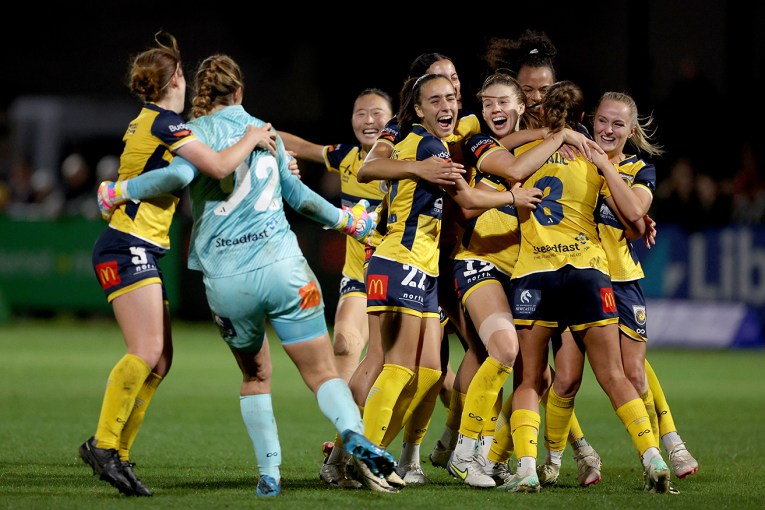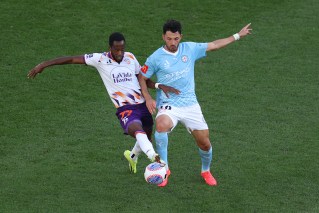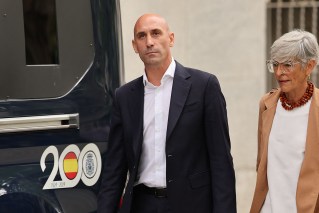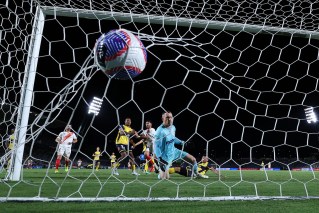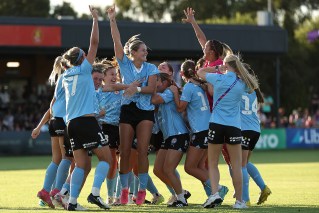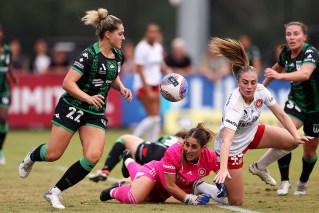Awful legacy for England’s 1966 World Cup team
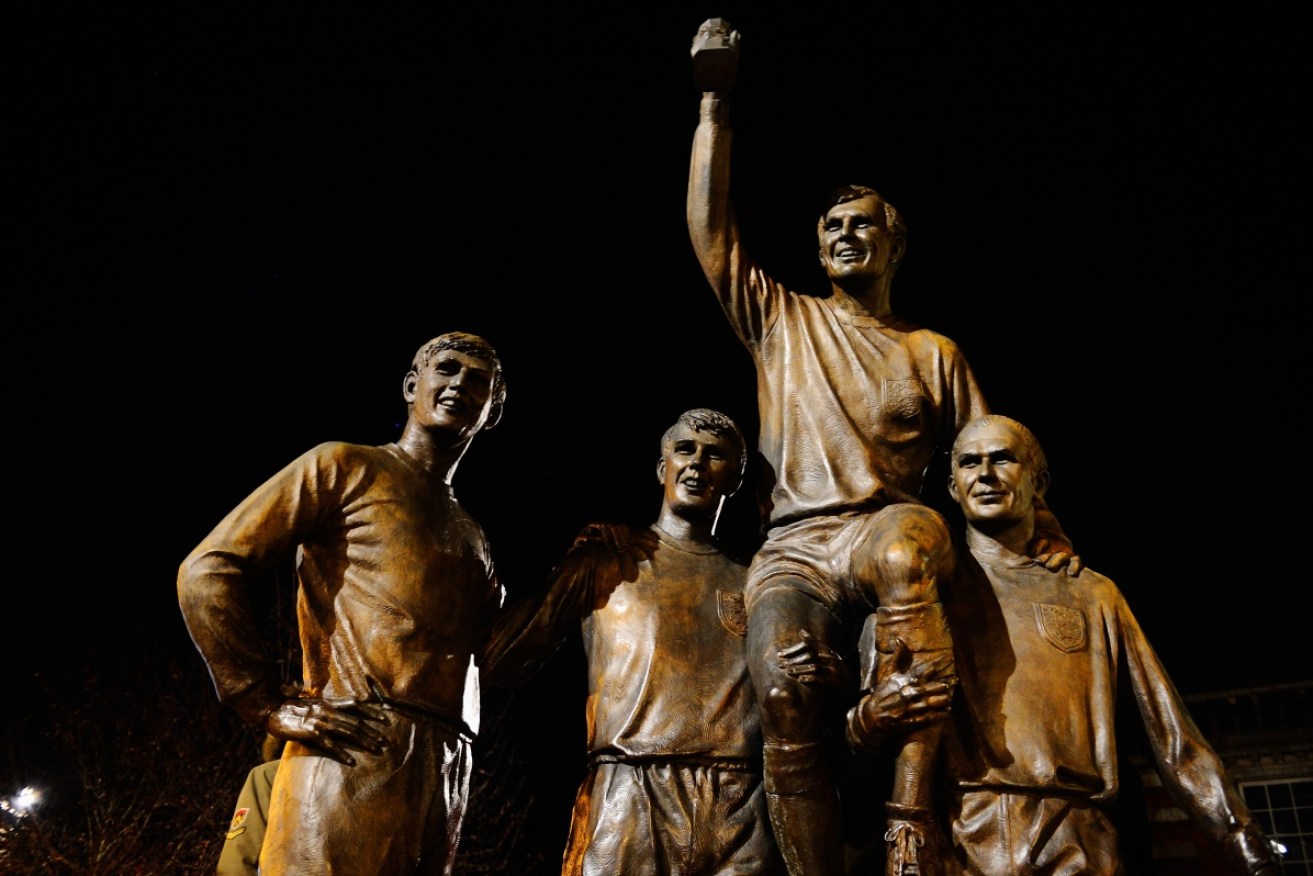
England World Cup heroes Bobby Moore, Geoff Hurst, Martin Peters and Ray Wilson immortalised in bronze – but their heads were not that hard and four of the team now suffer from dementia. Photo: Mike Hewitt/Getty
The surviving members of England’s 1966 World Cup winning side gathered in July to commemorate the 50th anniversary of their famous victory, but not everyone could make it.
Martin Peters, Nobby Stiles, Ray Wilson and Jack Charlton are all suffering from memory loss or dementia.
“It’s been widely reported that four of the team have got it,” John Stiles, Nobby Stiles’ son, told 7.30.
“I’ve been informed that in the squad it’s quite a few more.”
That’s way above the statistical average in the wider community.
“I spoke to Willie Stewart, who is a professor at Glasgow University, and he told me if you had two squads of 22, in other words 44 players, you might get one person (with dementia),” John Stiles said.
“That should be the average and the odds of (such high rates of dementia) happening are astronomical.”

Jack Charlton pictured with the 2012 Olympic Games torch. Photo: LOGOC/Getty
John Stiles believes his father’s brain was damaged by heading the football.
“Football (is) the only sport where a violent collision with another object is a daily occurrence and is part of the training,” he said.
“It just seems to me to be too much of a coincidence.”
Modern footballs are lighter and highly water resistant, unlike the heavy leather balls used in the past.
Players from the Sixties describe heading a heavy, waterlogged ball as like head butting a brick.
And they weren’t just doing that on game day – they were doing it day-in, day-out at training as well.

England’s legendary hero of the 1966 game Sir Geoff Hurst holds the heavy leather ball used in the World Cup Final. Photo: Ray Bradbury/Barcroft Images/Getty
George Cohen
George Cohen played at right-back in the famous team of ’66.
“Some of the balls used years ago were beasts — like cannon balls — when wet they were pretty nasty,” he told 7.30.
He is dismayed that as many as five of his former team mates from that side now have dementia, including Martin Peters, who scored the first goal in the final.

George Cohen pictured at Wembly this year. Photo: Dave J Hogan/Getty
“Martin … I can only say it’s dreadful,” he said.
“I saw him at a recent reunion and he wasn’t well.”
“He was very dear to me in as much as we were good friends, and his family are a lovely family, and when you see him like that…”
Jeff Astle
Jeff Astle couldn’t even remember he’d played football.
Brain specialists like Dr Michael Grey of the University of Birmingham have taken an interest in the unusually high number of former footballers who have been diagnosed with Alzheimer’s.
He believes that some players may well have Chronic Traumatic Encephalopathy (CTE) – something more commonly associated with boxers.
“It’s a brain disorder that is caused by a long period, or a career if you will, of damage to the brain, typically from sport,” Dr Grey told 7.30
“The challenge here is that the science and the symptoms of dementia are very similar to the signs and symptoms of CTE, and the only proper diagnosis of CTE with present technology is post-mortem.”

The Jeff Astle memorial gate in West Bromwich. Photo: Alex Morton/Getty
Jeff Astle was a star striker for West Bromwich Albion in the ’60s and ’70s, scoring 174 goals, many of them with his head.
“One comedian once said that Jeff Astle used to head the ball further than he went on holiday, which still makes me smile,” his daughter, Dawn Astle told 7.30.
“He learned off what they say was the former greatest header of the ball ever, which was Tommy Lawton when he was at Notts County.”
“Sadly, Tommy Lawton died of dementia.”
Jeff Astle was diagnosed with CTE after he died in 2002.
“He was 54 when he was diagnosed and he died at 59,” his widow, Laraine Astle told 7.30.
“He didn’t remember he played football, had no recollection at all.”
“A leading pathologist, a guy who examined Dad’s brain, said it was very similar to a boxer’s,” Dawn Astle said.
“And he said that it was the repeated heading of footballs that had caused the damage.”
The coroner agreed with the pathologist, ruling that Astle’s death was caused by industrial disease — his brain had been damaged by heading footballs.
The family took it up with the English Football Association (FA).
“When it was proven that football had killed him, industrial disease, I did get in touch with the FA and asked what they were going to do about it,” Laraine Astle said.
“And I did receive a letter from their solicitors, and it was a nasty letter, it really was — basically saying, you know, they’d take us to court.”
FA quietly dropped promised research into heading and brain injuries
John Stiles
Eventually the FA promised to conduct research into the link between heading the ball and brain injuries.
But in 2014, 12 years after Astle died, a newspaper reporter told the Astles the research was never completed.
“We contacted the FA, we were fuming about it, that nothing had been done,” Dawn Astle said.
“And they emailed me back to say that they did start research but it had basically collapsed.”
“They did it on 30-odd youngsters, none of them had made it into the professional game, all of them dropped out.”
“So I said what did you do after that then, nothing? Well, that’s not good enough. That’s not good enough.”
John Stiles thinks it’s worse than that.
“Personally, I think it’s a cover-up,” he told 7.30.
“There’s been delaying tactics, I think its been kicked into the long grass.”
“I think it’s something they don’t want to deal with.”
George Cohen is also concerned.
“There’s a sort of secrecy going on,” he said.
“I feel they don’t want to come out with the conclusion its football-related, foot to ball, head to ball related, maybe because there may be a court case.”
No-one from the FA would talk to 7.30.
West Brom campaigns for answers
With no answers coming from the FA, the Astles turned to Jeff’s club, West Bromwich Albion, and its fans.
“We went to West Brom basically with a flier on saying, ‘What killed Jeff Astle? Why did Jeff Astle die? Why hasn’t the research been done?’,” Dawn Astle said.
The club held special Jeff Astle days and fans clapped during the 9th minute at every game in tribute to their favourite number 9.
Finally the message seemed to get through, the campaign appeared to have worked.
A couple of months ago the FA met with the Astle family.
“I think we all felt, as we walked out, that it was probably the first time having met with people in suits that I actually felt that something would be done,” Dawn Astle said.
The English Football and Rugby Associations have agreed to hold a joint research symposium on concussion at the end of the year.
The Astle family will be making sure the FA follows through.
They say they owe it to the hundreds of families of footballers who have approached them, from the ’66 World Cup winners to lower league players.
“We won’t allow them to sweep it under a carpet, we have far too many people relying on us,” Laraine Astle said.
“We will fight it to the last and we’ll never, ever, ever, give in.”
– ABC Europe correspondent Steve Cannane
